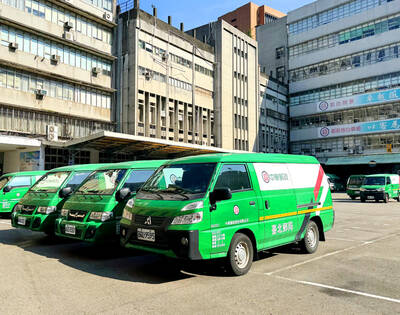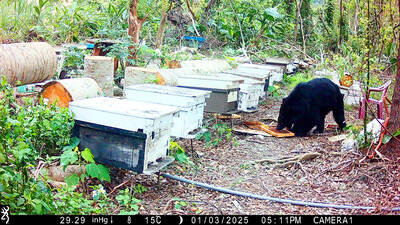Fifty-five days before election day, officials for the Democratic Progressive Party (DPP) said the party is “moving the frontline of the 2012 presidential election to the Da-an River (大安溪)” in central Taiwan, after gaining ground in recent public opinion surveys.
The move shows that the DPP thinks it has made great strides in central Taiwan, a traditional stronghold of the Chinese Nationalist Party (KMT), and is ready to target northern support in the remainder of the presidential campaign.
The Da-an River, which flows along the border of Miaoli County and Greater Taichung City, divides north and central Taiwan.
The statement also has great meaning to the DPP, as it would no longer be a party that only enjoys strong support south of the Jhuoshuei River (濁水溪), which runs along the border of Changhua County and Yunlin County and is traditionally used as the border of southern Taiwan, as well as a “watershed” between the DPP and the KMT.
Conventional analysis holds that the DPP has been increasing its lead in southern Taiwan and the KMT still has a solid lead in northern Taiwan, making central Taiwan the potential “game-changing” battleground.
Recent surveys showed that the support rate of DPP Chairperson Tsai Ing-wen (蔡英文) in central Taiwan — Greater Taichung, Changhua County and Nantou County, which is sandwiched between the Jhuoshuei and Da-an rivers — has surpassed that of KMT candidate President Ma Ying-jeou (馬英九), a senior aide of Tsai’s campaign said.
The Chinese-language magazine the Journalist on Wednesday quoted an anonymous KMT official as saying that an undisclosed KMT survey showed that Tsai is leading Ma in central Taiwan by 10 percentage points, and by 2 to 3 percentage points overall.
The aide also said that Tsai had overtaken Ma in central Taiwan, a region with about 2.4 million voters.
“I believe we can win in Changhua [County and City] and the old Taichung County, which was not an easy task in the past,” he said.
He added that the DPP is expected to lose in Nantou [County and City] by a small margin, given that it is the hometown of KMT vice presidential candidate Wu Den-yih (吳敦義).
“If we can draw even in old Taichung City, we can win central Taiwan,” he said.
The turnaround did not occur because the DPP had done anything special, but because of several fatal mistakes the KMT made, he said.
The DPP had already closed the gap in the region in the Greater Taichung mayoral election, in which its candidate Su Jia-chyuan (蘇嘉全), who was later named as Tsai’s running mate, lost by only about 30,000 votes, or 2.24 percent. Su had made central Taiwan his priority campaign area after his nomination as vice presidential candidate.
Ma had mishandled many issues in the same period, which included his talk of a peace agreement with China within 10 years, the arrest of a Taiwanese diplomat by the US over a human rights violation and the much-criticized spending of NT$215 million (US$7 million) on a musical, the aide said.
The DPP could not afford to be too relaxed in central Taiwan as “a lot of things can happen in 55 days,” but it could finally push north into the Hakka constituencies and the Greater Taipei area of Taipei City and New Taipei City (新北市) with increased confidence, said another senior aide in charge of national campaign operations, who wished to remain anonymous.
It does not have to vie for Hakka support from scratch because Tsai, a Hakka, has made a couple of successful campaign visits to Miaoli, Hsinchu and Taoyuan and does not rule out visiting there again.
The DPP is confident it would register a vote share of more than 40 percent in Hakka-populated counties, which would be unprecedented given that its previous high of 39 percent came in former president Chen Shui-bian’s (陳水扁) re-election campaign in 2004.
“If we can manage to cut the deficit in Taipei and New Taipei City to less than 100,000 votes, I think we can pull off a win,” the aide said.

SHIPS, TRAINS AND AUTOMOBILES: The ministry has announced changes to varied transportation industries taking effect soon, with a number of effects for passengers Beginning next month, the post office is canceling signature upon delivery and written inquiry services for international registered small packets in accordance with the new policy of the Universal Postal Union, the Ministry of Transportation and Communications said yesterday. The new policy does not apply to packets that are to be delivered to China, the ministry said. Senders of international registered small packets would receive a NT$10 rebate on postage if the packets are sent from Jan. 1 to March 31, it added. The ministry said that three other policies are also scheduled to take effect next month. International cruise ship operators

NUMBERS IMBALANCE: More than 4 million Taiwanese have visited China this year, while only about half a million Chinese have visited here Beijing has yet to respond to Taiwan’s requests for negotiation over matters related to the recovery of cross-strait tourism, the Tourism Administration said yesterday. Taiwan’s tourism authority issued the statement after Chinese-language daily the China Times reported yesterday that the government’s policy of banning group tours to China does not stop Taiwanese from visiting the country. As of October, more than 4.2 million had traveled to China this year, exceeding last year. Beijing estimated the number of Taiwanese tourists in China could reach 4.5 million this year. By contrast, only 500,000 Chinese tourists are expected in Taiwan, the report said. The report

The Forestry and Nature Conservation Agency yesterday launched a gift box to market honey “certified by a Formosan black bear” in appreciation of a beekeeper’s amicable interaction with a honey-thieving bear. Beekeeper Chih Ming-chen (池明鎮) in January inspected his bee farm in Hualien County’s Jhuosi Township (卓溪) and found that more than 20 beehives had been destroyed and many hives were eaten, with bear droppings and paw prints near the destroyed hives, the agency said. Chih returned to the farm to move the remaining beehives away that evening when he encountered a Formosan black bear only 20m away, the agency said. The bear

Chinese embassy staffers attempted to interrupt an award ceremony of an international tea competition in France when the organizer introduced Taiwan and displayed the Republic of China flag, a Taiwanese tea farmer said in an interview published today. Hsieh Chung-lin (謝忠霖), chief executive of Juxin Tea Factory from Taichung's Lishan (梨山) area, on Dec. 2 attended the Teas of the World International Contest held at the Peruvian embassy in Paris. Hsieh was awarded a special prize for his Huagang Snow Source Tea by the nonprofit Agency for the Valorization of Agricultural Products (AVPA). During the ceremony, two Chinese embassy staffers in attendance